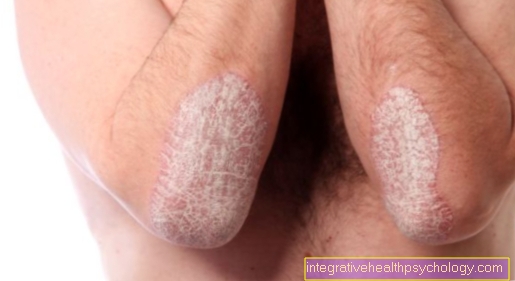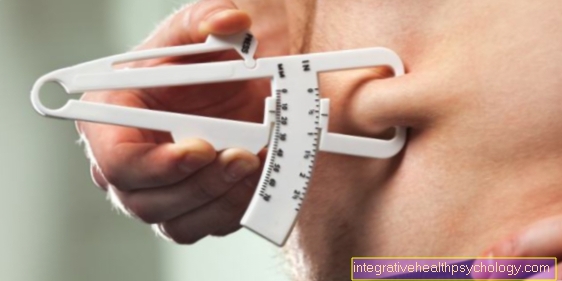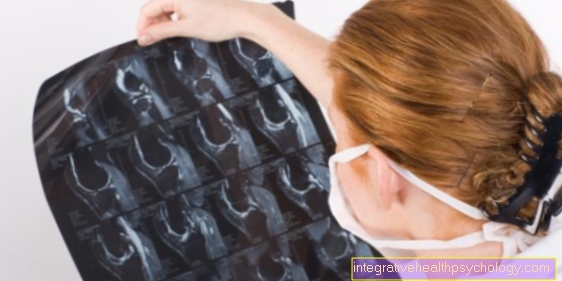Volkmann triangle
definition
The Volkmann triangle denotes a crack of the bone in the area of the ankle. The fracture results in an injury to the lower end of the shin bone. Due to the special anatomy of the ankle joint, a triangle of bones can be split off on the front edge as well as on the rear edge of the shin bone. Depending on the location of the blast, one speaks of a front or a rear Volkmann triangle.

Causes of a Volkmann triangle
The causes for the development of a Volkmann triangle are mostly due to severe trauma to the ankle. This can often occur in the context of sports accidents, but traffic accidents can also transfer enough force to the ankle and thus create a Volkmann triangle. In such cases, the Volkmann triangle is a typical injury to young, sporty people.
However, a Volkmann triangle can also arise with a minor ankle trauma. The prerequisite for this is a reduction in bone density. It typically affects older women. After the hormonal change in menopause, some of the female sex hormones drop in concentration. These hormones are important for stable bone structure, so if they are eliminated, a reduction in bone density can result. With increasing age, the bone density continues to decrease. Even minimal trauma, such as simply twisting an ankle, can lead to severe bony injuries to the ankle. Older people in particular are at risk of such injuries due to their general unsteadiness.
Read more information on this topic under: Broken ankle
Accompanying symptoms in a Volkmann triangle
The Volkmann triangle arises from a severe ankle injury with a fracture of the bones involved. First of all, a pain in the affected ankle becomes noticeable, which is usually so severe that you can no longer step on the affected foot.
In addition, the ankle swells quickly, and a bruise may also occur if a vessel is injured.
If the ankle is broken in such a way that a Volkmann triangle is formed, it is usually a serious injury. As a result, the ankle is often very unstable. In addition, accompanying injuries such as a tear in the inner and outer ligaments occur. This also adds to the instability of the ankle.
Occasionally, the fracture in the ankle is such that the ankle is unstable even on the bones. Then the bones involved in the joint no longer sit correctly on one another, the ankle joint may even look deformed from the outside. In the worst case scenario, bone piercing can occur. Then one of the broken bones bores its way through the skin from the inside so that it is visible from the outside.
You might also be interested in our next article: Torn ligament at the ankle
Frequently accompanying injuries in the Volkmann triangle
In the case of a Volkmann triangle, it is usually not just the bone that splits off from the shin bone. Often the anatomy of the ankle is also disturbed. The joint is made up of the tibia, fibula and talus. Between these bones are connective tissue and ligament structures that hold the bones together. Often in the context of the ankle joint injury there is a rupture of the syndesmosis between the tibia and fibula. This makes the ankle particularly unstable. The inner and outer ligaments are also often injured.
Diagnosis of a Volkmann triangle
The diagnostic manager usually begins with an anamnesis in which the doctor asks about the course of the accident. This is followed by a physical examination of the ankle. Movement restrictions and instabilities in the ankle can be noticed here. Imaging is then usually carried out using X-rays. In this recording, the bone damage can be assessed. The Volkmann triangle is often best seen in the lateral view of the ankle.
To rule out injuries to other structures such as the ligaments, an MRI is occasionally performed. If the bony situation cannot be fully assessed using the x-ray, a computed tomographic (CT) examination of the ankle can also be performed.
For detailed information on this topic, see: MRI of the foot
Therapy of a Volkmann triangle
The treatment of the ankle fracture with a Volkmann triangle consists of different phases. In the acute situation of the accident, initial measures after PECH (break, ice, compression, lying down) are useful.
The current physical activity should therefore be stopped. Then you put the ankle up, immobilize it with a compression bandage or another splint and cool the ankle. In this way, pronounced swelling can be counteracted and the first pain is alleviated.
If the compression and cooling succeed in minimizing the swelling, a quick ankle operation can then be performed.
If the swelling is too great, you have to wait a few weeks until the tissue is no longer so full of fluid.
If there is an open fracture of the ankle, the resulting wound must be covered in sterile first aid so that no germs get into the wound. A severe misalignment can already be corrected by the emergency doctor after the administration of sedatives and painkillers.
If the Volkmann triangle has broken off in an anatomically correct position, conservative therapy using a vacuum splint can be carried out. However, if the broken bones are shifted against each other, surgery is necessary. Depending on which bones are broken, an operation on the tibia, fibula and talus using screws, nails and plates is necessary. The Volkmann triangle itself has split off from the shin bone and is usually fixed again with a screw.
When is an operation necessary for a Volkmann triangle?
Surgery of the Volkmann triangle is necessary in most cases. Conservative treatment can only be chosen if the individual pieces of bone lie against one another in their anatomically correct position. So there is a good chance that they will grow together without complications.
If the bones are displaced from their anatomical position, an operation is necessary. The displaced bone fragments must be brought back into the correct position. The ankle structure can be restored using screws, nails and plates.
Duration
After a fracture of the ankle joint with the formation of a Volkmann triangle, both conservative and surgical treatment requires relieving the affected ankle for at least six weeks. During this time, the leg must initially not be loaded at all, later partially. A stabilizing splint is also worn.
Then a physiotherapeutic exercise of the ankle can take place. Depending on your physical fitness and progress in physiotherapy, you should expect a duration of a few to several weeks.
It usually takes about 3 months until the ankle is fully operational again, depending on which sport is being performed. The healing time may be delayed if the swelling of the ankle is so severe at the beginning that surgery cannot be performed. It usually takes about two weeks for the swelling to subside and treatment to begin.
Healing process
The healing process in a Volkmann triangle initially depends on whether conservative or surgical treatment is taking place.
With conservative treatment, the bone must grow together by itself. In the process, a bony structure, called a callus, forms first, which forms bone bridges. These then have to harden so that they are able to bear the load on normal bone again.
During an operation, the fracture surfaces are pressed directly against one another using screws and plates. In this way, more direct bone healing can take place. In the meantime, the stress on the ankle is placed on the inserted screws and plates.
After the bone has healed, physiotherapy takes place, in which the muscular stability of the ankle is to be rebuilt. With strength and stabilization exercises, the coordination can gradually improve. Depending on the desired goal (everyday ability, sports ability, extreme sports ability), the training can be ended when the therapy goal is achieved.





























